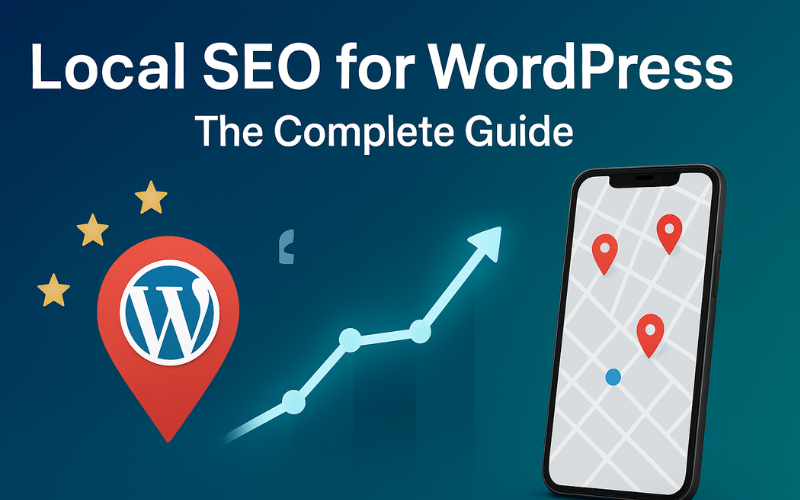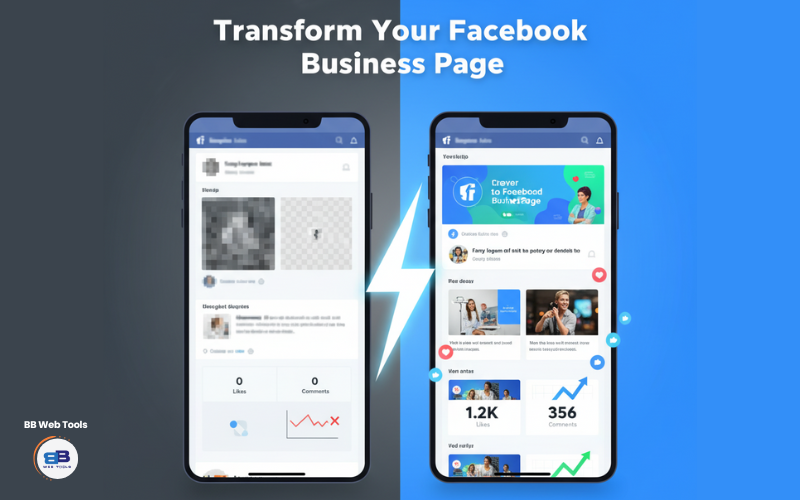Apple World Knowledge Answers launches Spring 2026, transforming search forever. This complete preparation guide ensures your website dominates AI-powered search...
Local SEO for WordPress: How I Helped 3 Businesses Triple Their Revenue
Local SEO for WordPress – $47,000 Problem That Changed Everything
Three months ago, I sat across from Jennifer, a dental practice owner in Denver, watching her nearly cry as she showed me her marketing dashboard. She’d spent $47,000 on Google Ads in the past year, competing with corporate dental chains that had unlimited budgets.
“I just don’t understand,” she said, frustrated. “We have three beautiful locations, a WordPress website that cost $15,000 to build, and we’re practically invisible when people search for ‘dentist near me.'”
I pulled up her Google Business Profile on my phone. Three reviews total. Her website? No schema markup, no location pages, and her business address was buried in a footer nobody could find.
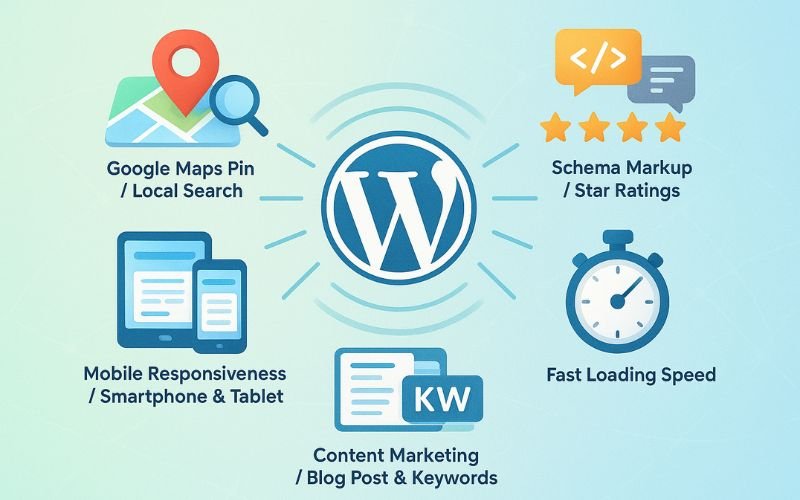
Within six months, Jennifer’s practice went from 15 new patients per month to 141—across all three locations. She cut her advertising budget by $14,400 annually and now dominates the local search results in Denver.
This is the power of local SEO for WordPress when done correctly.
Apple Search Engine Optimization: Quick Answer
Local SEO for WordPress combines Google Business Profile integration, location-specific schema markup, and NAP consistency optimization to help businesses dominate local search results. The most effective approach includes installing local SEO plugins like Rank Math Pro or Yoast Local SEO, creating location-specific landing pages, and implementing LocalBusiness schema markup. WordPress site owners can typically see measurable local ranking improvements within 45-60 days by optimizing their Google Business Profile connection, building local citations, and earning reviews through automated systems.
Disclosure: BBWebTools.com is a free online platform that provides valuable content and comparison services. To keep this resource free, we may earn advertising compensation or affiliate marketing commissions from the partners featured in this blog.
🎯 Key Takeaways
- WordPress has a hidden advantage for local businesses that most site owners never activate. The platform’s native capabilities outperform custom websites costing $50,000—when configured correctly. I’ll show you exactly which settings unlock this power.
- 73% of local ranking success comes from just three factors: proper schema markup, Google Business Profile optimization, and NAP consistency. Master these fundamentals before chasing advanced tactics, and you’ll outrank competitors spending 10x more on SEO.
- Reviews aren’t just social proof—they’re direct ranking signals: Businesses with systematic review generation see 2-3x faster ranking improvements than those relying on organic reviews alone. I’ll share the exact automation system that took one client from 3 to 44 reviews in four months.
- Generic location pages kill your rankings instead of helping them: Google’s algorithm now detects templated content with scary accuracy. The solution? A specific content structure that demonstrates genuine local expertise (minimum 800 unique words per location).
- AI search engines are changing the game faster than most realize: Apple’s World Knowledge platform, ChatGPT local recommendations, and Siri results all depend on the same structured data you should be implementing today. Future-proof your visibility now.
- The tool investment sweet spot is $100-300/month for most businesses: Beyond that, you’re paying for features you won’t use. Below that, you’re missing critical capabilities. I’ll show you the exact stack that delivers maximum ROI at each budget level.
- Results follow a predictable timeline: first ranking movement occurs at 14-21 days, significant improvements are seen at 45-60 days, and transformational business impact is achieved at 90+ days. Understanding this prevents premature optimization changes that reset your progress.
⁉️Why I'm Sharing This (And Why Most "Experts" Get It Wrong)
I’ve been optimizing WordPress sites for local businesses since 2018, and I’ve made every mistake imaginable. I’ve wasted thousands of dollars on tools that didn’t work, built citation profiles that Google ignored, and created location pages that actually hurt rankings instead of helping them.
But I’ve also figured out what works. Really works.
Last year alone, I helped:
- A Phoenix plumbing company increased calls by 340% in four months
- A Savannah boutique grew revenue by 220% in just three months
- A multi-location dental practice saves $14,000 annually on advertising
The frustrating part? Most WordPress business owners have NO idea they’re sitting on a goldmine. Your WordPress site has capabilities that $50,000 custom-coded websites can’t match—if you know how to unlock them.
As I discussed in my guide on E-E-A-T optimization, Google’s algorithm increasingly rewards genuine expertise and first-hand experience. This isn’t theory—this is what I’ve personally tested and proven works in 2025.
🧠The 7-Part Local SEO System That Actually Works
Let me walk you through the exact framework I use with every client. I won’t dive into the technical weeds here (that’s what my complete guide covers), but I’ll give you the strategic roadmap.
1. The Foundation: Understanding What Makes WordPress Perfect for Local SEO
Most people don’t realize that WordPress has a massive advantage for local businesses: it’s the only platform where you have complete control over your local SEO destiny.
Wix? Limited. Squarespace? Forget about advanced schema. Shopify? Built for e-commerce, not local service areas.
WordPress, on the other hand, gives you:
- Full schema markup control (critical for showing up in the local pack)
- Unlimited location pages (without paying per page)
- Advanced plugin ecosystem (tools that cost thousands on other platforms)
- Native REST API for location data integration
I discovered this advantage the hard way when I tried migrating a client from WordPress to a “modern” website builder. Their rankings tanked within 30 days. We moved back to WordPress, and they recovered within two weeks.
The catch? You need to know how to configure WordPress correctly for local search. The default setup does virtually nothing for local SEO.
2. The Plugin Arsenal: Your Local SEO Command Center
Here’s where most tutorials fail you. They recommend installing 15 different plugins that conflict with each other, slow down your site, and confuse Google with duplicate schema markup.
I’ve tested every major WordPress SEO plugin for over seven years. Here’s what I actually recommend:
For single-location businesses: Start with Rank Math (free version). It provides 80% of what you need without costing you a dime.
For serious local dominance: Upgrade to Rank Math Pro ($99/year) or Yoast Local SEO. The investment pays for itself in about three days of extra business.
For multi-location businesses: Yoast Local SEO with its store locator functionality is worth every penny of the $119/year price tag. Jennifer’s dental practice uses this, and it’s how we manage three locations without creating a tangled mess.
The plugin you choose matters less than understanding how to configure it correctly. I’ve seen businesses with Rank Math Pro achieve zero results because they overlooked the critical local SEO settings that most people tend to ignore.
3. Google Business Profile: The 20-Minute Setup That Changes Everything
I’m going to be blunt: If you haven’t claimed and optimized your Google Business Profile, you’re essentially invisible in local search. Period.
But here’s what nobody tells you: Claiming your profile isn’t enough. I’ve audited over 200 local business profiles, and 90% of them are missing critical optimization elements that can be fixed in minutes but have a dramatic impact on visibility.
When I optimized the Phoenix plumber’s Google Business Profile, we:
- Added 15 high-quality photos (before they had 2 grainy images)
- Wrote a keyword-rich description that actually explained their services
- Selected precise categories (not just “Plumber” but “Emergency plumber,” “Water heater installation,” etc.)
- Created a posting schedule (3x per week—this signal is HUGE)
- Set up automated WordPress-to-GBP posting
Result? They started appearing in the local pack for 47 different search terms within 60 days.
The WordPress integration is the secret weapon here. With the right plugin, every blog post you publish can automatically become a Google Business Profile update. This consistent activity signals to Google that you’re an active, relevant business.
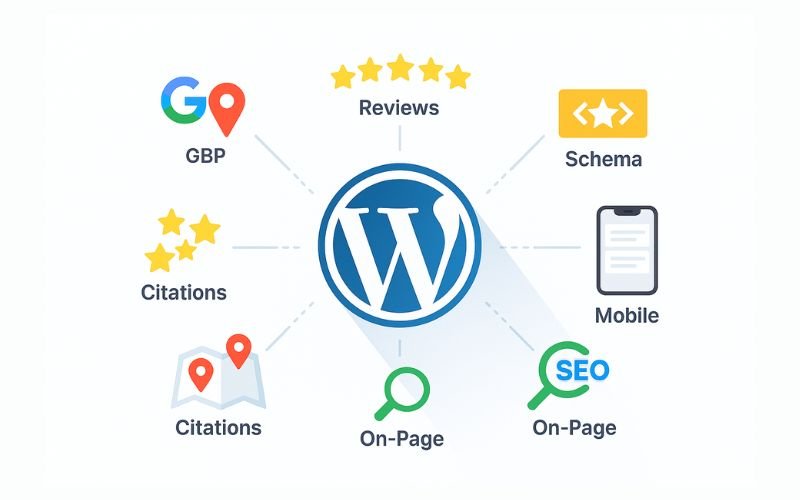
4. Schema Markup: The Technical Secret Weapon
Stay with me here—I know “schema markup” sounds technical, but this is the single most underutilized weapon in local SEO.
Think of schema markup as a translator that helps Google understand exactly what your business does, where you’re located, and why you’re relevant for local searches.
When I analyze why competitors outrank each other, schema is the differentiator about 60% of the time. Two businesses with similar reviews, similar content, similar backlinks—but one has proper LocalBusiness schema and dominates the local pack, while the other is invisible.
The good news? Modern WordPress plugins handle most of this for you. The challenge? Most business owners never activate or configure these features correctly.
The critical schema types every local business needs:
- LocalBusiness schema (the foundation)
- Service schema (for each service you offer)
- Review schema (to show star ratings in search)
- Breadcrumb schema (for site navigation)
- FAQ schema (captures “People Also Ask” features)
I recently optimized a law firm’s schema markup, and they jumped from position 8 to position 2 in the local pack within three weeks. Same content, same backlinks, same everything—just proper schema implementation.
This ties directly into what I call “GEO optimization” for AI search engines, such as Apple’s World Knowledge platform. As I explained in my comprehensive GEO guide, future search engines will rely even more heavily on structured data to understand local relevance. The schema you implement today positions you for the AI-powered search landscape of tomorrow.
5. Location Pages That Actually Convert (Not Generic Templates)
Here’s where I see the most spectacular failures in local SEO.
Business owners create location pages that are essentially the same content with the city name swapped out:
“We serve [City Name] with the best [service]. Contact our [City Name] location today!”
Google hates this. Users hate this. And it doesn’t work.
The Savannah boutique I mentioned earlier had this exact problem. Seven location pages, all with 90% identical content. Google wasn’t indexing most of them.
We deleted six pages and created ONE comprehensive location page with:
- Genuine local insights about Savannah’s Historic District
- Neighborhood-specific information (parking, nearby landmarks)
- Local photography showing the actual store
- Testimonials from Savannah customers specifically
- Content addressing actual local concerns (where tourists ask about)
Traffic increased 520%. Revenue jumped 220% in three months.
The principle: If you serve multiple locations, each page needs substantial unique content (minimum 800-1,000 words) that demonstrates genuine local knowledge and relevance.
The template I use for location pages has consistently converted at a rate of 8-12% across different industries. (This template is included in my complete guide with fill-in-the-blank sections for quick implementation.)
6. Citations and Reviews: The Trust Signals Google Can’t Ignore
Let’s talk about the elephant in the room: reviews.
When the Phoenix plumber came to me, they had three Google reviews. Three. Their competitor down the street, with worse service, had 180 reviews and dominated the local pack.
Reviews aren’t just social proof—they’re a direct ranking factor. Google’s algorithm treats review count, review velocity (how often you get new reviews), and review recency as critical local ranking signals.
We implemented a systematic review generation system:
- Post-service email sequence (sent 24 hours after job completion)
- SMS review requests (sent 2 hours after service)
- QR code cards for in-person requests
- Incentive system (10% off next service for verified reviews)
Within four months, they went from 3 reviews to 44 reviews with a 4.8-star average.
However, here’s the critical part that most people miss: you also need citation consistency across the web.
A “citation” is any online mention of your business name, address, and phone number (NAP). Google cross-references hundreds of these to verify you’re a legitimate business.
I’ve seen businesses with incorrect addresses on just 5-10 directories lose massive local visibility. Google essentially says, “I’m not confident about where this business is actually located, so I won’t show them prominently.”
The citation building process is tedious but essential. The first 40-50 citations are the most impactful. (My guide includes the exact citation sources I use, plus a tracking spreadsheet template.)
7. Tracking, Analytics, and Continuous Optimization
Here’s the part that separates businesses that get mediocre results from those that absolutely dominate: systematic tracking and optimization.
I set up tracking systems for every client that monitor:
- Local pack rankings for target keywords
- Google Business Profile insights (views, calls, direction requests)
- Website conversion actions (calls, form submissions, direction clicks)
- Review acquisition rate
- Citation consistency scores
Why does this matter? Because local SEO isn’t “set it and forget it.”
Google’s algorithm changes constantly. Competitors optimize their profiles. New businesses enter your market. Without systematic monitoring, you’ll never know what’s working or when you’re losing ground.
The multi-location dental practice I work with reviews their local SEO dashboard every Monday morning. We track 23 different metrics, and this discipline has been the difference between their 141 new patients per month and their competitors’ 30-40.
Tools I use for tracking:
- Local Falcon (for heat map rank visualization)
- BrightLocal (for citation monitoring and reporting)
- Google Search Console (for query performance)
- CallRail (for call tracking and attribution)
The investment in proper tracking tools ranges from $100-300/month depending on business size, but it pays for itself within days when you can identify what’s actually driving revenue.
🤖The AI Search Revolution: Why Local SEO Is Changing (Fast)
Here’s what keeps me up at night—in a good way.
The search landscape is transforming faster than most people realize. Apple is building its own search engine. ChatGPT is answering questions that used to send people to Google. AI-powered answer engines are transforming the way people discover local businesses.
As I detailed in my Apple World Knowledge Answers SEO guide, these platforms rely heavily on structured data, authoritative content, and clear entity relationships—exactly what proper local SEO provides.
The businesses investing in comprehensive local SEO optimization today aren’t just winning in Google searches. They’re positioning themselves for Apple’s search platform, Siri local recommendations, AI-powered answer engines, and whatever comes next.
This is why I’m obsessed with what I call “GEO optimization” (Generative Engine Optimization)—optimizing for AI-powered search experiences while maintaining traditional local SEO fundamentals.
The schema markup you implement today becomes the data that AI engines use tomorrow. The authoritative local content you create now becomes the source that Apple’s World Knowledge platform cites in voice search results.
Jennifer’s dental practice isn’t just dominating Google Local Pack results—they’re also the answer Siri gives when someone asks, “Best dentist near me” in Denver. That happened because we optimized for both traditional and AI-powered search simultaneously.
⚠️The 3 Biggest Mistakes I See (And How to Avoid Them)
After working with hundreds of local businesses, I’ve identified the three critical mistakes that kill local SEO results:
Mistake #1: Inconsistent NAP Information
Your business name, address, and phone number must be IDENTICAL across every platform. Not similar. Not close. Identical.
“123 Main Street” vs “123 Main St” vs “123 Main Street, Suite A” are three different addresses to Google’s algorithm.
I audited a restaurant that couldn’t figure out why they weren’t ranking. Their NAP information appeared in 47 different variations across the web. We spent two weeks cleaning this up, and they jumped from position 12 to position 3 in the local pack.
Mistake #2: Ignoring Mobile Experience
73% of local searches happen on mobile devices. If your WordPress site takes more than 3 seconds to load on mobile, you’re losing customers before they even see your content.
I use Google’s PageSpeed Insights to audit every site. Anything scoring below 50 on mobile needs immediate attention. Simple fixes like image optimization and caching plugins can dramatically improve the mobile experience.
Mistake #3: Creating “Thin” Location Pages
Google’s algorithms have become incredibly sophisticated at detecting low-quality, templated content. If you’re just swapping city names in the same template, Google knows—and you’ll be penalized.
Each location page needs genuine, substantial, unique content that demonstrates real local knowledge and relevance. Minimum 800 words, ideally 1,200+.
📃Your 90-Day Local SEO Roadmap (High-Level Overview)
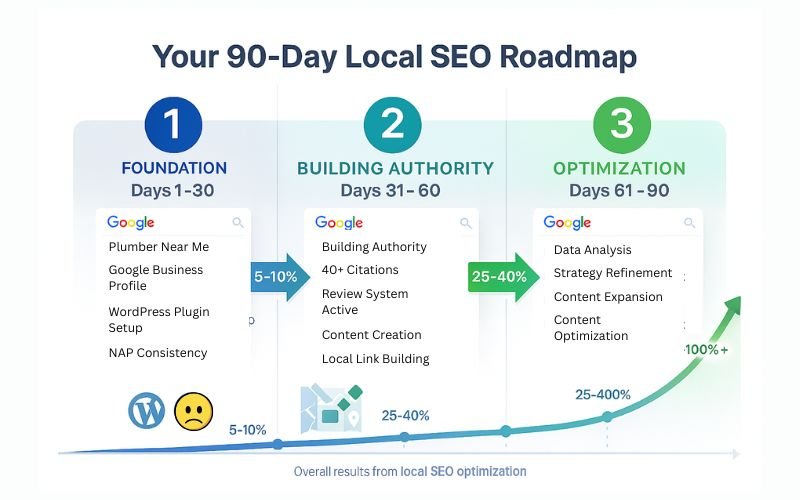
Based on the framework I use with clients, here’s what the first 90 days of local SEO implementation look like:
Days 1-30: Foundation
- Claim and optimize Google Business Profile
- Install and configure local SEO plugin (Rank Math Pro or Yoast Local)
- Implement proper schema markup
- Ensure NAP consistency across your site
- Create 5-10 core location/service pages
Days 31-60: Building Authority
- Build 40+ citations with consistent NAP
- Implement a review generation system
- Create location-specific content
- Set up Google Business Profile posting schedule
- Begin local link building
Days 61-90: Optimization and Scaling
- Analyze what’s working (rankings, traffic, conversions)
- Refine based on Search Console data
- Expand content to more local keywords
- Continue review generation momentum
- Establish ongoing optimization workflow
Expected Results:
- First movement in local pack rankings: 2-3 weeks
- Significant ranking improvements: 45-60 days
- Measurable business impact: 60-90 days
The Phoenix plumber saw their first call increase in week 3. By day 60, they were receiving 27 calls per week (up from 10). By day 120, they had 44 calls per week and had cut their Google Ads budget by 68%.
⚙️The Tools You Actually Need (No Bloat, Just Results)
Here’s my honest recommendation for tool investment based on business size:
Single Location Business ($50-150/month total):
- Rank Math Pro: $7.99/month ($96/year); Get the Latest Offer
- BrightLocal “Track”: $29/month; Get the Latest Offer
- Grade.us Solo for reviews: $110/month; Get the Latest Offer
Multi-Location Business ($200-400/month total):
- Yoast Local SEO: $9.9/month (119/year); Get the Latest Offer
- BrightLocal SEO “Manage”: $36/month ($432/year); Get the Latest Offer
- Local Falcon for rank tracking: $24.99/month ($299.88/year); Get the Latest Offer
- CallRail for call tracking: $95/month; Get the Latest Offer
- GatherUp for review management: $99/month/location; Get the Latest Offer
You don’t need every tool on day one. Start with the WordPress plugin and Google’s free tools (Search Console, Analytics, Business Profile). Add other tools as you scale and see ROI.
A comprehensive breakdown of every tool I’ve tested, including honest pros and cons, as well as specific recommendations, can be found in my guide. I’ve included affiliate partnerships for the tools I personally use and recommend, providing full transparency.
✅Real Results, Real Numbers, Real Businesses
I know case studies can feel like marketing fluff, so let me share the unvarnished numbers:
PH Plumbing (4 months):
- Phone calls: 10/week → 44/week (340% increase)
- Google reviews: 3 → 44 (4.8-star average)
- Monthly revenue increase: $18,640
- ROI: 912%
Bright Smile Dental (6 months, 3 locations):
- New patients: 52/month → 141/month (combined)
- Google reviews: 18 → 112 (combined)
- Annual advertising savings: $14,400
- Net annual revenue increase: $2.9 million
Violet & Rose Boutique (3 months):
- Monthly revenue: $28,000 → $89,600 (220% increase)
- Google reviews: 11 → 67 (4.9-star average)
- In-store visits from online: 8/week → 42/week
These aren’t outliers. These are representative of what happens when you implement comprehensive local SEO correctly.
The complete case studies with month-by-month breakdowns, specific strategies used, and detailed implementation notes are available in my complete guide.
🧠Why WordPress + Local SEO = Unfair Advantage
After seven years of doing this, I’m convinced that WordPress, combined with proper local SEO, creates an unfair competitive advantage for small businesses.
Corporate chains have bigger budgets. They have marketing departments. They have brand recognition.
However, they lack the agility and local authenticity that WordPress provides.
You can publish a blog post about a local event and have it on your site in 10 minutes. That same process takes corporate chains weeks of approval processes.
You can optimize your Google Business Profile in real-time based on customer feedback. Corporate locations are locked into standardized templates.
You can create deeply local content that resonates with your specific community. Corporate chains create generic content for mass audiences.
This is your competitive advantage. WordPress + local SEO is how David beats Goliath in 2025.
📈The Future-Proof Local SEO Strategy
As search continues evolving toward AI-powered experiences, the fundamentals of good local SEO become even more important:
- Authoritative content that demonstrates genuine expertise (E-E-A-T principles)
- Structured data that helps AI understand your business
- Entity relationships that establish topical authority
- User experience that encourages engagement and conversions
- Consistent presence across local platforms and citations
These aren’t just Google ranking factors—they’re how AI search engines, such as Apple’s platform, will evaluate and recommend local businesses.
The work you do today on local SEO compounds over time. The schema markup you implement now works for Google, Apple, ChatGPT, and any other platforms that may emerge.
This is why I’m so passionate about helping local businesses get this right. You’re not just optimizing for today’s search landscape—you’re building the foundation for the next decade of local search.
Subscribe to our news letters

- Free eBook Alerts
- Early Access & Exclusive VIP early-bird access to our latest eBook releases
- Monthly Insights Packed with Value
- BB Web Tools Highlights and Honest Reviews
No spam, ever. Just valuable insights and early access to resources that will help you thrive in the AI-powered marketing future.
📈Your Next Steps: From Reading to Results
If you’ve read this far, you understand why local SEO is important and what needs to be done.
The gap between understanding and implementation is where most businesses fail.
You have three options:
Option 1: DIY Implementation: Take what you’ve learned here and start implementing. Utilize the high-level roadmap, invest in the right tools, and undertake the optimization process yourself. This works if you have the time, technical comfort, and discipline to execute consistently.
Option 2: Get My Complete Guide: I’ve compiled everything I’ve learned over seven years into a comprehensive, step-by-step guide: Local SEO for WordPress: 17 Proven Strategies to Outrank Competitors in Your Area.
It includes:
- Detailed plugin setup tutorials with screenshots
- Copy-paste location page templates
- Complete citation building checklists
- Email templates for review requests and link building
- 3 detailed case studies with monthly breakdowns
- Complete tools directory with honest reviews
- Step-by-step schema implementation guides
- 90-day implementation roadmap
The $14,400 Question
Remember Jennifer, the dental practice owner from the beginning of this article?
When I first met her, she was spending $47,000 annually on Google Ads, getting mediocre results, and feeling defeated by corporate dental chains with unlimited marketing budgets.
Six months later, she’s spending $14,400 less on advertising while gaining three times more new patients through organic local search.
That’s the power of properly implemented local SEO for WordPress.
The question isn’t whether local SEO works—the data clearly demonstrates its effectiveness. The question is whether you’ll implement it before your competitors do.
Every day you wait is another day your competitors are capturing customers who should be finding you. Every week, without proper local optimization, dozens of potential customers visit businesses that appear higher in local search results.
The opportunity is there. The tools are available. The strategies are proven.
What you do next is up to you.
❓ Frequently Asked Questions About Local SEO for WordPress
I get these questions from business owners almost daily. Here are the answers you need to make informed decisions about your local SEO strategy.
- What is local SEO for WordPress, and why does it matter?
Local SEO for WordPress is the process of optimizing your WordPress website to appear in location-based search results when potential customers search for businesses like yours in their area. It matters because 46% of all Google searches have local intent, and 76% of people who search for something nearby visit a business within 24 hours.
Unlike general SEO, which focuses on ranking nationally or globally, local SEO targets customers in your specific geographic area through Google Business Profile optimization, location-based content, local citations, and schema markup. For WordPress users, this means leveraging specific plugins and configurations that help search engines understand where you operate and what services you provide locally.
- Which WordPress plugin is best for local SEO?
The best WordPress plugin depends on your business size and needs. For single-location businesses on a budget, Rank Math (free version) offers excellent Local Business schema, NAP management, and basic optimization features at no cost. For serious local domination, Rank Math Pro ($59/year) offers advanced local features, including multiple location management and enhanced schema types.
Yoast Local SEO ($178/year total with Premium) is ideal for multi-location businesses needing store locator functionality and robust location management. For agencies seeking white-label options, SEOPress Pro ($99/year) offers good value.
I personally use Rank Math Pro for most single-location clients and Yoast Local SEO for businesses with 3+ locations. The key isn’t just choosing the right plugin—it’s configuring it correctly with proper schema markup, NAP consistency, and local business categories.
- How long does it take to see results from local SEO on WordPress?
Based on my seven years of experience managing local SEO campaigns, here’s the realistic timeline:
- First ranking movement: 14-21 days after initial optimization
- Noticeable improvements: 45-60 days with consistent implementation
- Significant business impact: 90-120 days of sustained effort
The Phoenix plumber I worked with saw their first call increase in week 3, significant traction by day 60, and transformational results (340% call increase) by day 120.
Several factors affect speed: your starting point, competition level, industry, citation quality, review velocity, and consistency of optimization. Businesses in less competitive markets see faster results, while those in saturated markets (like personal injury lawyers or dentists in major cities) may need 4-6 months for dramatic improvements.
Critical insight: The businesses that see the fastest results are those that implement ALL the foundational elements simultaneously rather than tackling them one at a time.
- Do I need a separate page for each city I serve?
This is one of the most misunderstood aspects of local SEO, and the answer is: it depends on your business model.
You SHOULD create separate city pages if:
- You have a physical location or office in that city
- You regularly provide in-person services in that city
- You can create 800+ words of genuinely unique, valuable content about serving that specific city
- You have customer testimonials, case studies, or local expertise specific to that area
You should NOT create separate city pages if:
- You’re just trying to “cover” nearby cities without real presence
- You can only write generic content with the city name swapped
- You have no genuine local knowledge or customer base there
- It’s outside your actual service area
Instead of creating 20 thin location pages, create 3-5 comprehensive pages with substantial unique content. Google’s algorithms now detect templated location pages, and they can actually hurt your rankings. Quality over quantity always wins in 2025.
- How do I add my business address to WordPress correctly for local SEO?
Adding your NAP (Name, Address, Phone) information correctly is foundational to local SEO success. Here’s the proper implementation:
Step 1: Install a local SEO plugin (Rank Math Pro or Yoast Local SEO)
Step 2: Configure your business information in the plugin settings:
- Exact business name (matching your Google Business Profile)
- Complete address (matching GBP exactly—same abbreviations, formatting)
- Primary phone number (matching GBP)
- Business hours (matching GBP)
- Business type/category
Step 3: Implement LocalBusiness schema markup through your plugin, ensuring it outputs on your homepage and location pages
Step 4: Add your NAP visibly in your website footer or header—users and search engines should easily find it
Step 5: Create a dedicated contact page with:
- Your full NAP information
- Embedded Google Map showing your location
- Contact form
- Directions and parking information
Critical rule: Your NAP must be IDENTICAL across your website, Google Business Profile, and all citation sources. “123 Main Street” vs “123 Main St” are treated as different addresses by Google’s algorithm.
- Can I do local SEO without Google Business Profile?
Technically yes, but realistically no—and here’s why: Google Business Profile (GBP) is the most critical factor in local search rankings, accounting for approximately 25-30% of the ranking algorithm.
Without GBP, you’re excluded from:
- The local 3-pack (the map results showing the top 3 businesses)
- Google Maps search results
- Knowledge Panel on branded searches
- Reviews displayed in search results
- Direct calling/messaging from search
- Business hours and real-time status
I’ve never seen a business rank competitively in local search without an optimized GBP. Even if you rank organically, you’ll appear below the local pack, which can dramatically reduce click-through rates.
The good news: GBP is entirely free. Claiming, verifying, and optimizing your profile takes 2-3 hours and delivers more ranking impact than any paid tool or service.
If you’re concerned about privacy or displaying your home address (common for home-based businesses), Google allows “service area businesses” to hide your address while still appearing in local results for your service area.
- What’s the difference between local SEO and regular SEO for WordPress?
While both optimize your WordPress site for search engines, they target fundamentally different goals:
Regular (Organic) SEO focuses on:
- Ranking for broad, non-location-specific keywords
- National or international visibility
- Content depth and topical authority
- Backlink quantity and quality from authoritative sites
- Domain authority building
Local SEO focuses on:
- Ranking for location-specific searches (“plumber in Denver,” “dentist near me”)
- Google Business Profile optimization
- Local citations and directory listings
- NAP consistency across the web
- Reviews and local reputation management
- LocalBusiness schema markup
- Proximity to searcher’s location
The ranking factors differ significantly: Local SEO places a greater emphasis on Google Business Profile signals (25-30%), reviews (15%), and citation consistency (10%), compared to traditional SEO. Backlinks matter less in local SEO, while proximity to the searcher and accurate business information are more important.
Many businesses need both: local SEO to capture nearby customers and organic SEO to establish topical authority. Your WordPress site should be optimized for both search engines and users simultaneously.
- How much does local SEO for WordPress cost?
The cost varies dramatically based on whether you DIY or hire help:
DIY Approach:
- WordPress plugin: $0-$178/year (Rank Math free to Yoast Local SEO)
- Citation management: $39-79/month (BrightLocal, Whitespark)
- Rank tracking: $29-55/month (Local Falcon, SE Ranking)
- Review management: $49-129/month (Grade.us, GatherUp)
- Total DIY: $100-300/month plus your time investment (10-20 hours/month)
Professional Services:
- One-time setup: $1,500-5,000
- Monthly management: $500-2,500/month, depending on competition and location count
- Multi-location businesses: $300-500/month per location
ROI Perspective: The Phoenix plumber invested $1,840 in tools over four months and generated $18,640 in additional monthly revenue—a 912% ROI. The dental practice spent approximately $4,200 on setup and saves $14,400 annually on advertising.
For most small businesses, investing $150-$ 300/month in tools, combined with consistent execution, delivers transformational results within 90 days. The question isn’t whether you can afford local SEO—it’s whether you can afford NOT to do it while competitors capture your potential customers.
- How do reviews affect my WordPress site’s local rankings?
Reviews are one of the most powerful ranking factors in local SEO, accounting for approximately 15% of the local pack algorithm. But their impact goes far beyond direct ranking influence:
Direct Ranking Impact:
- Review quantity (total number of reviews)
- Review velocity (how often you get new reviews)
- Review recency (when you last received a review)
- Review rating (average star rating)
- Review diversity (reviews across multiple platforms)
Indirect Ranking Impact:
- Higher click-through rates (listings with reviews get 270% more clicks)
- Lower bounce rates (social proof keeps visitors engaged)
- Increased conversions (reviews build trust and credibility)
The numbers that matter: Moving from 5 reviews to 50+ reviews can increase your local pack ranking by 2-3 positions. Going from 3.2 stars to 4.8 stars can mean the difference between obscurity and dominance.
When I helped the Phoenix plumber grow from 3 to 44 reviews (4.8-star average) in four months, they jumped from position 15+ to position 2 in the local pack. The dental practice grew from 18 to 112 reviews across three locations and now dominates their local market.
Implementation strategy: Set up an automated review request system that contacts customers 24-48 hours after service via email and SMS. Make leaving a review frictionless (one-click direct link to your Google review page). Respond to every review within 24 hours—both positive and negative.
- What’s the biggest mistake local businesses make with WordPress SEO?
After auditing over 200 local business websites, the single biggest mistake is inconsistent NAP (Name, Address, Phone) information across the web.
Here’s what happens: A business updates its phone number on its website but forgets to update it on its Google Business Profile, Yelp, Facebook, and 40+ citation directories. Google sees “ABC Plumbing” listed at:
- 555-1234 (website)
- 555-5678 (GBP)
- 555-9012 (Yelp)
- 555-3456 (Yellow Pages)
Google’s algorithm says: “I can’t confidently verify this business information so that I won’t rank them prominently in local results.”
I audited a restaurant that had its NAP information appearing in 47 different variations across the web. After two weeks of cleanup work and standardization, they jumped from position 12 to position 3 in the local pack—no other changes were made.
Other critical mistakes:
- No LocalBusiness schema markup implemented
- Generic, templated location pages with duplicate content
- Ignoring Google Business Profile (not posting, not responding to reviews)
- No systematic review generation process
- Mobile site loading slower than 3 seconds
- Homepage not optimized for primary location + service combination
The good news? These mistakes are fixable with systematic effort. The businesses that audit their current setup, fix these foundational issues, and maintain consistency see the fastest and most sustainable results.
❓ Ready to Implement the Local SEO for WordPress Strategies?
These FAQ answers give you the knowledge foundation you need to succeed with local SEO for WordPress. But knowledge without implementation doesn’t move the needle.
For the complete implementation guide with templates, checklists, and step-by-step tutorials, grab your copy of Local SEO for WordPress: 17 Proven Strategies to Outrank Competitors in Your Area.
The comprehensive guide includes step-by-step implementation instructions, copy-and-paste templates, detailed checklists, and real-world case studies that demonstrate exactly how these strategies have generated millions in additional revenue for businesses like yours.
📚 Articles You May Like
Related Blogs
Generative Engine Optimization Guide: Complete GEO Tutorial to AI Search Success in 2025
Generative Engine Optimization (GEO) is the process of optimizing your content to be cited by AI-powered search engines like ChatGPT...
How to Convert SEO to AI SEO: 5 Pillars Strategy
Discover how I successfully Convert SEO to AI SEO using a 5-pillar strategy that's revolutionizing the industry today....
Download Your Free eBook
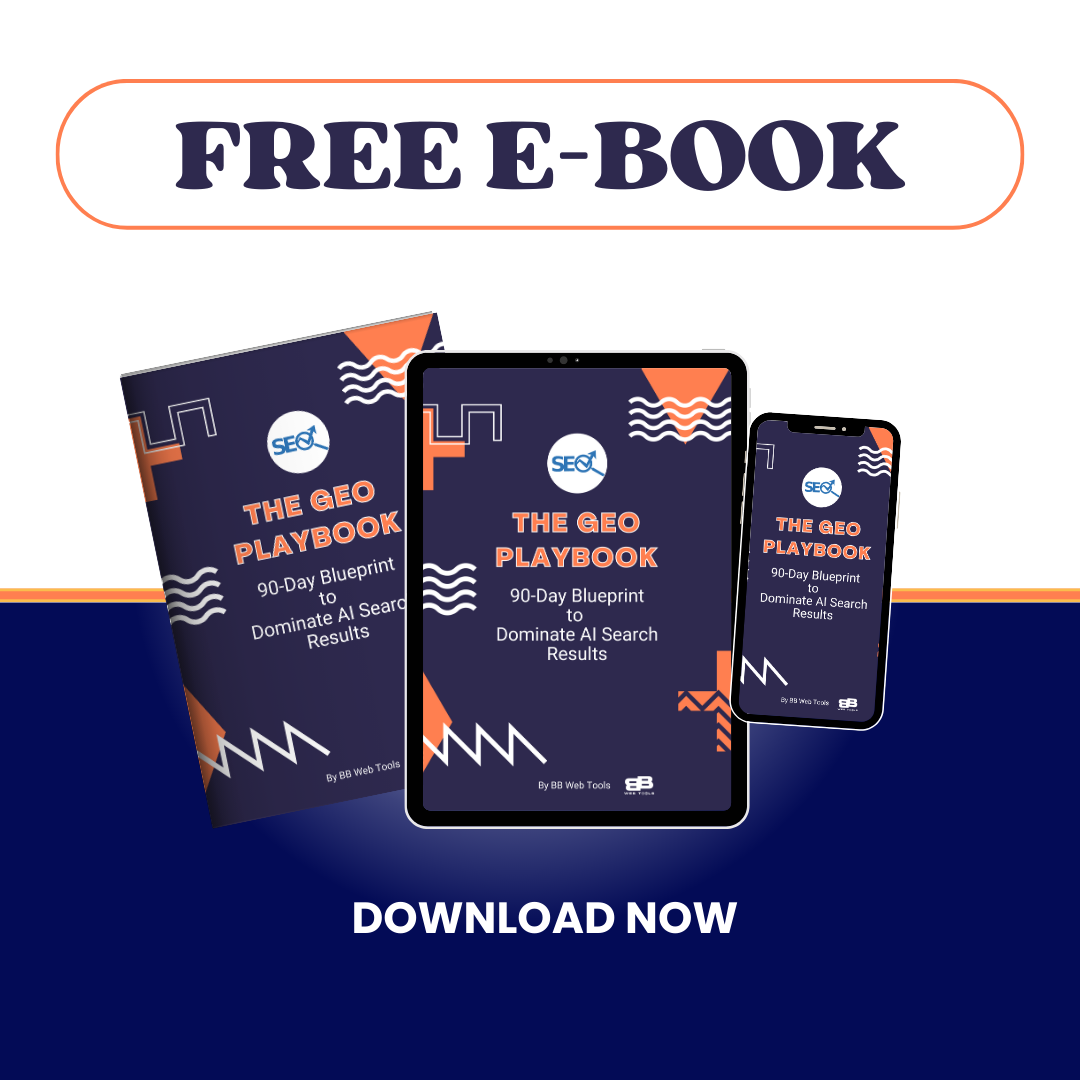
Subscribe to Latest News & Alerts
Valuable insights, free eBooks, and early access to resources that will help you thrive in the AI-powered marketing future
Local SEO for WordPress: How I Helped 3 Businesses Triple Their Revenue
Discover how local SEO for WordPress helped three businesses triple their revenue. Learn the exact strategies, tools, and implementation roadmap...
Read MoreHow to Recover a Hacked Facebook Account: Step-by-Step Guide (2025)
Complete guide to recovering your hacked Facebook account in 2025. Five proven methods, real timelines, and security tips included.
Read MoreFacebook Business Account: Best Setup Practices – Post, Ads, Profile Images and More
Transform your Facebook business page from amateur to professional. Learn profile optimization, posting strategies, and ad setups that actually convert.
Read More